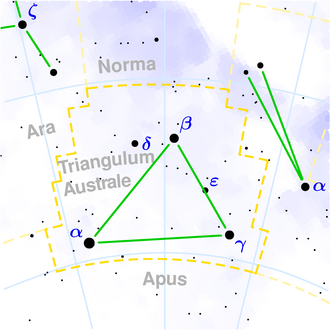NGC 6156
| Galaxy NGC 6156 |
|
|---|---|
|
|
|
| AladinLite | |
| Constellation | Southern triangle |
|
Position equinox : J2000.0 , epoch : J2000.0 |
|
| Right ascension | 16 h 34 m 52.5 s |
| declination | -60 ° 37 ′ 08 ″ |
| Appearance | |
| Morphological type | (R ') SAB (rs) c / LIRG |
| Brightness (visual) | 11.6 mag |
| Brightness (B-band) | 12.3 mag |
| Angular expansion | 1.6 ′ × 1.4 ′ |
| Position angle | 0 ° |
| Surface brightness | 12.3 mag / arcmin² |
| Physical data | |
| Affiliation | LGG 407 |
| Redshift | 0.010885 ± 0.000019 |
| Radial velocity | 3263 ± 6 km / s |
|
Stroke distance v rad / H 0 |
(141 ± 10) x 10 6 ly (43.1 ± 3.0) Mpc |
| history | |
| discovery | John Herschel |
| Discovery date | April 24, 1835 |
| Catalog names | |
| NGC 6156 • PGC 58536 • ESO 137-033 • IRAS 16304-6030 • 2MASX J16345255-6037075 • SGC 163029-6030.8 • GC 4203 • h 3632 • HIPASS J1634-60 • LDCE 1172 NED143 | |
NGC 6156 is a 11.6 likes bright barred spiral galaxy with an active galactic nucleus from Hubble type SBc in the constellation Corona Australis. It is an estimated 141 million light years away from the Milky Way and about 70,000 light years in diameter.
The object was discovered on April 24, 1835 by John Herschel with an 18-inch reflector telescope, which during two observations "pF, R, gpmbM, 45 arcseconds, in a field full of small stars" and "pF, lE, glbM, 50 arcseconds long ”.
